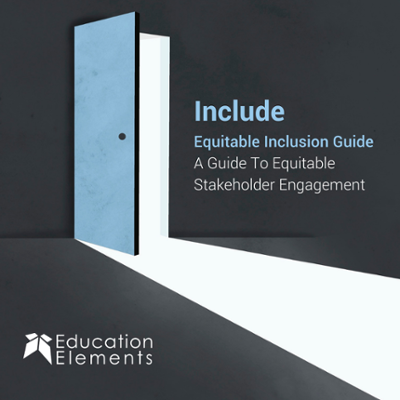
opening the door for inclusion: a guide
equity | district leadership | school leadership
at the beginning of last week, my colleagues purvi patel, dave hardy, and i were excited to welcome leaders participating in our inaugural cohort of the systems of educational equity development (seed) fellowship after a well-deserved break and launch the beginning of our include sessions.
within our systems for education equity methodology (seem), include is designed to help leaders and designers disrupt and break invisible conditions preventing true inclusion of those most disenfranchised and marginalized within their current systems.
wednesday we watched, with the rest of our nation, the privilege and power afforded to white disruptors and white rioters, as well as the white violence on display. the assaults stunned those in our country, and we experienced an even greater emotional toll as a consequence of seeing and hearing the manifestation of invisible conditions used to uphold white dominance. this was seen when:
- white people defended the rioters’ actions, and/or juxtaposed their own actions against those at the capitol
- discussions ignored the double standards between the treatment of black lives matter protesters and capitol rioters
- people rationalized the aggressive and violent action taken at the capitol and expressed shared values with the privileged and dominant group
- these views were legitimized based on the notion that we must make space for all perspectives
the attack on our capitol and the discussions around our country serve as new examples of what equitable inclusion is and is not. they better contextualized for us all, why inclusion efforts fail, despite the best intentions to elevate the voices of those most marginalized within our education system.
equitable inclusion must:
-
focus on equity over equality of those included
ask yourself: are you actively elevating the voices and opinions of those at the margins? or are you making space for all to be heard in the service of equality? -
create safe and personalized experiences for the specific groups you hope to hear from and most often do not
ask yourself: are you creating an inclusive environment based on the needs of the average or majority? or are you creating a differentiated approach in how to engage with those least trusting of the invitation? - be intentionally designed to mitigate against unconscious bias and invisible conditions
ask yourself: are you focusing on just having opportunities for marginalized groups to be included? or are you actively ensuring the entire experience works to remove barriers and inequitable conditions? -
be sustained and cyclical
ask yourself: are you creating a “one and done” approach that is isolated? or are you creating a robust cyclical process that is embedded within your system?
in our new equitable inclusion guide (phase 2 of our seem methodology), co-authored by jessica anderson, kimberley stewart, and me, we examine how leaders, designers, and organizations can create more equitable inclusion experiences based on the notion of “the inclusion room.”
prior to entering the room:
- what are the common barriers to equitable inclusion?
- how might we proactively mitigate barriers that may silence marginalized voices prior to them even entering the (engagement) room?
once in the room:
- what are the detours to equitable inclusion efforts?
- how might we ensure that once the marginalized groups are in the room the conditions and climate create the psychological safety needed for voices to be heard?
- how might we spot the detours of equitable inclusion practices once everyone is in the room?
type of room:
- what are the different engagement strategies available to designers?
- how might we select the correct engagement strategies and environment to meet the desired outcomes of the inclusion efforts?
designing the room:
- what are the best practices to follow? common pitfalls to avoid?
- how might we design, administer, and review data from an inclusive experience to inform next steps?
interested in learning more about how to create more equitable inclusion efforts? join us for our webinar, “barriers, detours, and practices to create equitable inclusive engagements” as a companion to the release of the inclusion guide on january 21st at 8am pst/ 11 am cst, or register to get access to the recorded session.
about crystal xu
crystal xu is a member of the design and implementation team, working with school districts around the country to plan and implement different change management processes to drive strategic change. prior to joining 瑞士vs喀麦隆亚盘赔率 , crystal served in various roles in both public and charter schools in houston, texas and atlanta, georgia. crystal served as a curriculum writer for 8-12 science, math and advanced placement classes, founding teacher, instructional coach for the national math and science initiative, assistant school leader, and district leader. crystal has extensive experience in designing and building new schools and programs to drive for change, most recently serving as the founding director of the metro atlanta teacher residency to acquire and train new teachers for the talent pipeline. crystal’s experience and passion also includes implementing personalized learning in high schools to better prepare students for a choice-filled life, data-driven systems to increase results as well as leadership development and instructional coaching. at 瑞士vs喀麦隆亚盘赔率 , crystal works extensively in crafting the equity methodology to ensure dei is at the forefront of systems level redesign and infused within instruction, leadership development and design-based solutions. when not working, crystal likes to connect with friends and family through a meal, read and explore different cities around the world. crystal holds a b.s in economics and international affairs from georgia tech and an mba from rice university.


-2-1.jpeg)

